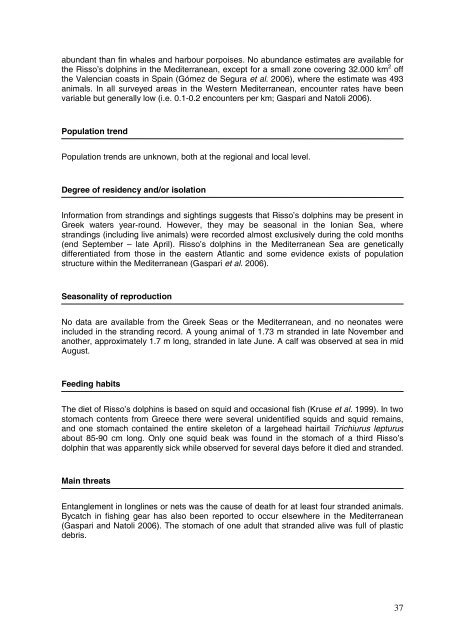Cetaceans in Greece: Present status of knowledge
Cetaceans in Greece: Present status of knowledge
Cetaceans in Greece: Present status of knowledge
Create successful ePaper yourself
Turn your PDF publications into a flip-book with our unique Google optimized e-Paper software.
abundant than f<strong>in</strong> whales and harbour porpoises. No abundance estimates are available for<br />
the Risso’s dolph<strong>in</strong>s <strong>in</strong> the Mediterranean, except for a small zone cover<strong>in</strong>g 32.000 km 2 <strong>of</strong>f<br />
the Valencian coasts <strong>in</strong> Spa<strong>in</strong> (Gómez de Segura et al. 2006), where the estimate was 493<br />
animals. In all surveyed areas <strong>in</strong> the Western Mediterranean, encounter rates have been<br />
variable but generally low (i.e. 0.1-0.2 encounters per km; Gaspari and Natoli 2006).<br />
Population trend<br />
Population trends are unknown, both at the regional and local level.<br />
Degree <strong>of</strong> residency and/or isolation<br />
Information from strand<strong>in</strong>gs and sight<strong>in</strong>gs suggests that Risso’s dolph<strong>in</strong>s may be present <strong>in</strong><br />
Greek waters year-round. However, they may be seasonal <strong>in</strong> the Ionian Sea, where<br />
strand<strong>in</strong>gs (<strong>in</strong>clud<strong>in</strong>g live animals) were recorded almost exclusively dur<strong>in</strong>g the cold months<br />
(end September – late April). Risso’s dolph<strong>in</strong>s <strong>in</strong> the Mediterranean Sea are genetically<br />
differentiated from those <strong>in</strong> the eastern Atlantic and some evidence exists <strong>of</strong> population<br />
structure with<strong>in</strong> the Mediterranean (Gaspari et al. 2006).<br />
Seasonality <strong>of</strong> reproduction<br />
No data are available from the Greek Seas or the Mediterranean, and no neonates were<br />
<strong>in</strong>cluded <strong>in</strong> the strand<strong>in</strong>g record. A young animal <strong>of</strong> 1.73 m stranded <strong>in</strong> late November and<br />
another, approximately 1.7 m long, stranded <strong>in</strong> late June. A calf was observed at sea <strong>in</strong> mid<br />
August.<br />
Feed<strong>in</strong>g habits<br />
The diet <strong>of</strong> Risso’s dolph<strong>in</strong>s is based on squid and occasional fish (Kruse et al. 1999). In two<br />
stomach contents from <strong>Greece</strong> there were several unidentified squids and squid rema<strong>in</strong>s,<br />
and one stomach conta<strong>in</strong>ed the entire skeleton <strong>of</strong> a largehead hairtail Trichiurus lepturus<br />
about 85-90 cm long. Only one squid beak was found <strong>in</strong> the stomach <strong>of</strong> a third Risso’s<br />
dolph<strong>in</strong> that was apparently sick while observed for several days before it died and stranded.<br />
Ma<strong>in</strong> threats<br />
Entanglement <strong>in</strong> longl<strong>in</strong>es or nets was the cause <strong>of</strong> death for at least four stranded animals.<br />
Bycatch <strong>in</strong> fish<strong>in</strong>g gear has also been reported to occur elsewhere <strong>in</strong> the Mediterranean<br />
(Gaspari and Natoli 2006). The stomach <strong>of</strong> one adult that stranded alive was full <strong>of</strong> plastic<br />
debris.<br />
37


